Huge projects require even bigger crawlers
17 April 2024
A trend in the market for both types of crawler crane, telescopic and lattice boom, is that the focus continues to move up the capacity scale. Niamh Marriott reports.
Progressively heavier loads are needing to be lifted, and crane manufacturers have had to adapt and produce ever-larger models to meet these huge project demands.
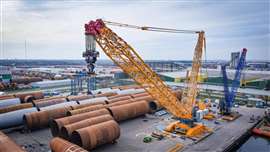 Sarens took delivery of the first unit of Liebherr’s new 2,500 tonne capacity crawler crane. (Photo: Sarens)
Sarens took delivery of the first unit of Liebherr’s new 2,500 tonne capacity crawler crane. (Photo: Sarens)
International heavy lift and transport specialist Sarens is continuing to meet this challenge and is regularly adding high lifting capacity cranes to its extensive fleet.
In 2023, Sarens took delivery of the first unit of Liebherr’s new 2,500 tonne capacity crawler crane, the LR 12500-1.0. Rostock in Germany was the first place the LR 12500-1.0 was put to work for Sarens’ client Van Oord where it lifted 50 monopile foundations for offshore wind turbines. Each one had a diameter of up to nine metres and a length of up to 90 metres. They were lifted into the water in tandem with an 800 tonne capacity Liebherr LR 1800-1.0 lattice boom crawler crane.
At the time of writing Sarens was in final negotiations with Liebherr on the acquisition of a second LR 12500-1.0 for delivery in 2024.
ICST spoke exclusively to Sarens’ senior R&D engineer, and crawler crane expert, Hendrik Sanders. When asked the main differences and advantages of lattice boom versus telescopic boom crawler cranes, Hendrik explains, “It has to do with the duration of the job. Depending on the duration of a particular job, telescopic cranes are a real advantage as you can travel easier to site than with lattice boom cranes, and the set up can be done in a few hours, so it’s a very fast assembly.
“With a lattice boom crane, you have to transport the body separately. Though if it’s a smaller crane, the tracks can still be on, so you can drive it straight from the trailer.
“If the job is only for a few days, there’s no point having a lattice boom crawler crane if the job can be done by a telescopic crane. It’s too difficult with the planning stage too for a short job.
“And there’s a price difference, rental of a lattice boom crane is cheaper than a comparable telescopic crane., but the mobilisation and demobilisation cost is considerably more expensive.
“The advantage of a crawler crane is that you can travel with a load. When you have a telescopic crane, positioned at a certain distance from the load, you cannot approach once the crane is set up. If you are missing capacity for one or two metres extra radius, there is not much you can do. Let’s say with a crawler crane, the crane body is more compact. You mostly can get closer to the load.
“You can do a job with a smaller lattice boom crane compared to a telescopic crane, because the lighter lattice boom offers more lifting capacity, and you can move with the load. So, this is sometimes an advantage. Some clients have a misunderstanding initially because of the ability of a crawler crane to move with a load, so they want to use it as a means of transport. We do not want this and tell clients that traveling with a load, should only be done over short distances. It is not a replacement for a truck or a lorry. Only cranes up to the 180 tonne class can have tractor type of crawler chains. These bulldozer type of tracks don’t exist with the bigger models.
“With the bigger models, the crawler pads are not mounted on a chain, but are running on steel rollers incorporated in the chassis of the crawler. And they are very prone to wear. So, if you drive extensive distances, you will wear out the tracks quickly and it’s very expensive to refurbish the tracks.”
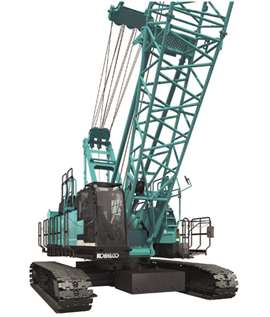 Three updated models announced from Japanese crawler crane manufacturer Kobelco. (Photo: Kobelco)
Three updated models announced from Japanese crawler crane manufacturer Kobelco. (Photo: Kobelco)
New crawlers are being launched to market and other established models are also getting updated to meet legislative requirements and industry demand. Three new generation models were recently announced from Japanese crawler crane manufacturer Kobelco.
They are G-4 series models of 100, 150 and 250 tonnes capacity. All have Isuzu diesel engines to meet the European Stage V exhaust emission standard. The latest versions with EU Stage V engines follows the announcement of seven new generation CK series models for the US market earlier in 2023.
In addition to the new engines, the 150 tonne capacity CKE1350G-4 and the 250 tonne CKE2500G-4 have new cabins said to improve visibility, functionality and productivity.
Chinese design
When asked about the main difference between Chinese and the European manufacturers of crawlers, Sarens’ Hendrik says, “Chinese manufacturers are trying out several innovations.
“For instance, a mini super lift for boom erection built into the back of the crane. This is useful because in lattice boom cranes, one of the main challenges is boom erection. If you can erect the main boom without a derrick attachment, it’s an advantage because you want to avoid rigging the back mast. You can then avoid transporting additional ballast to site for boom erection. I think that the recent developments seen in lattice boom cranes have been triggered by the wind turbine industry. Previously it was wind turbines on land but the latest development is in the offshore industry, especially now the USA market is getting involved.
“We get a lot of requests now to deploy crawler cranes or lattice boom cranes for marshalling. This means to put a crane alongside the shore at the port, to prepare the towers and wind turbines for their sea voyage and the loading of the components on board of the sea-going vessel. For the bigger boom cranes in our fleet, that’s the major market for us now.
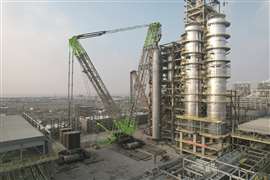 3,600 tonne capacity Zoomlion giant breaks more lifting records in China. (Photo: Zoomlion)
3,600 tonne capacity Zoomlion giant breaks more lifting records in China. (Photo: Zoomlion)
In January 2024 Chinese manufacturer Zoomlion claimed two world lifting records for its 3,600 tonne capacity lattice boom crawler crane on a project in China.
The ZCC89000 crawler crane with double lattice booms lifted three giant chemical processing vessels, the heaviest of which weighed more than 3,000 tonnes. Zoomlion claimed two world records, one for the heaviest single lift and the other for the fastest lifting speed.
Being able to install these reactors in single lifts advanced the construction schedule by two months, the crane maker says.
Crawler safety
Hendrik Sanders discusses safety when it comes to crawlers. He says, “The biggest challenge, as with many other crane types, is working at height. I must say that in the last 10 years, manufacturers have made real progress on this.
“With increasing wind turbine erection demand, where cranes have to be moved very often, there is a lot more working at height, but luckily the safety culture was already in place from the refinery and petrochemical jobs of the past. That industry was the first to have full time safety officers on their sites, and they have continued to lead in setting the standards for safety.
“There’s also been developments to ensure that workers have followed a safety training before they can enter on site.
“Standardisation of safety training has come later, as initially different companies each had their specific safety training. Now it is more standardised.”
Green crawlers
So, what’s in store for the future of crawlers? There is some movement with green technology and battery powered cranes being embraced by the industry, particularly in the USA.
D.Ann Shiffler, editor of ICST sister magazine ACT, says, “All the major crane manufacturers have been researching the concept of “green” cranes for several years, looking at cleaner fuels, zero emissions, noise reduction and electric motors. While smaller capacity crane makers have been offering these units for several years, higher-capacity cranes makers are getting in on the concept in a big way.”
At Bauma in October 2022 and at ConExpo in March 2023, several battery-operated cranes were displayed. Liebherr has now produced four LR 1250.1 Unplugged models, and two of those are now working in the USA.
Sims Crane and Equipment unveiled its Liebherr LR 1250.1 Unplugged in September 2023, and Bigge rolled out its new model in November 2023.
Big future
Sarens’ Hendrik Sanders is most excited about the increasing size of crawler cranes, adding, “For me I’m always interested in bigger crawler cranes. For say 15 years or so, a 600 tonne machine was a big crawler crane. Then it moved up to the 750 to 800 tonne class. But now we are looking at the 1,000 tonne class to become a common crane class. All this has mainly been driven by the wind turbine industry.
“We see that now more and more here in Europe, smaller crane companies have relatively big crawler cranes in their fleet. And it is all to do with the increasing heights of wind turbines, and it’s rising. For the moment, the maximum hub height here in Europe is about 180 metres. But this is not the standard yet. There are already quite some wind farms with turbines with 165 metres of hub height. But the expectation is that this will go up.”
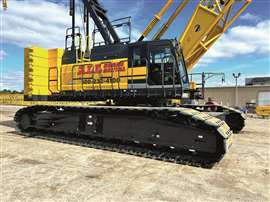 ALL added a new package of Kobelco G-3 Series hydraulic crawler cranes to its fleet. (Photo: ALL)
ALL added a new package of Kobelco G-3 Series hydraulic crawler cranes to its fleet. (Photo: ALL)
In January 2024 the All Family of Companies added a new package of Kobelco G-3 Series hydraulic crawler cranes to its fleet. The package includes the following units, in varying quantities: CK800G-3, CK1100G-3 and CK1600G-3. The new G-3 models were created using input from end users derived from real jobsite experiences.
They incorporate transport, assembly and operator-friendly concepts, the company says. Other features include boom, carbody and track side frame structures designed with ease of transport in mind. The G-3 Series cranes include a new cab design offering improved visibility and new features such as bluetooth and USB capabilities.
The new cranes are expected to be deployed across All’s 33-branch North American footprint, where they are expected to find ample work in bridge construction, plant work, foundation work and more.
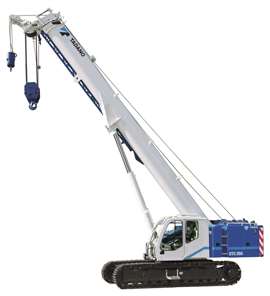 Tadano crawlers for Select Crane Sales. (Photo: Tadano)
Tadano crawlers for Select Crane Sales. (Photo: Tadano)
USA-based Select Crane Sales has placed an order for multiple 2024 Tadano GTC 350 crawler cranes.
The Tadano GTC 350 is a multi-purpose crawler crane ideal for general construction, powerline and foundation work. The crawlers offer a 32 tonne lifting capacity, three section 11 to 27 metre full power telescopic boom and extendable jib.
The GTC 350 has a pick and carry design, on a 4 degree slope the GTC maintains 83 per cent of level ground capacity when tracks are fully extended.
Its compact work dimensions, Opti-Width design and transport savings makes it the most practical crane on the job site.
STAY CONNECTED


Receive the information you need when you need it through our world-leading magazines, newsletters and daily briefings.




